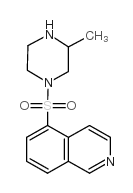Epidermal growth factor-induced heterologous desensitization of the luteinizing hormone/choriogonadotropin receptor in a cell-free membrane preparation is associated with the tyrosine phosphorylation of the epidermal growth factor receptor.
M L Lamm, R M Rajagopalan-Gupta, M Hunzicker-Dunn
Index: Endocrinology 140(1) , 29-36, (1999)
Full Text: HTML
Abstract
Epidermal growth factor (EGF) attenuated hCG-stimulated adenylyl cyclase activity in rat luteal and follicular membranes. H7, an equipotent serine/threonine protein kinase inhibitor of cAMP-dependent protein kinases, cGMP-dependent protein kinases, and lipid-dependent protein kinase C, did not effect the ability of EGF to decrease hCG-responsive adenylyl cyclase activity, suggesting that a serine/threonine phosphorylation event catalyzed by these kinases was not critically involved in EGF-induced desensitization. Likewise, pertussis toxin-catalyzed ADP-ribosylation of a 40-kDa luteal membrane protein, which exhibited immunoreactivity with an antibody against Gi alpha, did not hinder the ability of EGF to attenuate hCG-stimulated adenylyl cyclase activity, indicating that Gi did not mediate EGF-induced desensitization. Rather, EGF-induced heterologous desensitization of LH/CG receptor in ovarian membranes was closely associated with the specific and prominent tyrosine phosphorylation of the 170-kDa EGF receptor. Both EGF-stimulated autophosphorylation of EGF receptor and EGF-induced LH/CG receptor desensitization were attenuated by genistein, a tyrosine kinase inhibitor. These results suggest that tyrosine phosphorylation of the 170-kDa EGF receptor is a necessary component of the signaling pathway in EGF-induced heterologous desensitization of the LH/CG receptor.
Related Compounds
| Structure | Name/CAS No. | Molecular Formula | Articles |
|---|---|---|---|
 |
1-(5-ISOQUINOLINYLSULFONYL)-3-METHYL-PIPERAZINE
CAS:84477-73-6 |
C14H17N3O2S |
|
Production of interleukin (IL)-6 and IL-8 by a choriocarcino...
2000-05-01 [Placenta 21(4) , 354-60, (2000)] |
|
Alpha1-adrenergic regulation of peptidylglycine alpha-amidat...
1999-08-20 [Mol. Cell. Endocrinol. 154(1-2) , 89-100, (1999)] |
|
Protein kinase C inhibition blocks the early appearance of v...
1999-10-16 [Brain Res. 845(1) , 97-101, (1999)] |
|
The enhancing mechanism of capric acid (C10) from a supposit...
1997-04-01 [Biol. Pharm. Bull. 20(4) , 446-8, (1997)] |
|
The kinase inhibitor iso-H7 stimulates rat satellite cell di...
1996-06-01 [Cell Biol. Toxicol. 12(3) , 177-85, (1996)] |